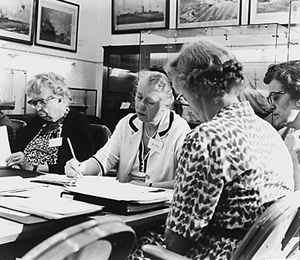The Equal Pay Act, signed in to law by President John F. Kennedy on June 10, 1963, was one of the first federal anti-discrimination laws that addressed wage differences based on gender. The Act made it illegal to pay men and women working in the same place different salaries for similar work.

P.G. Harris, US Employment Service War Manpower Commission, 1942-1945
During the first decades of the 20th century, women made up less 24% of the U.S. workforce. During World War II, however, labor shortages brought large numbers of women in to the workplace and by 1945, women made up 37% of the civilian workforce. Because women had traditionally earned less than men for doing similar work, male workers feared that this growing source of cheap labor would replace them or lower their wages. As men began to join the military and women began to take over their civilian jobs, unions started to advocate for equal pay. They felt that this would prevent employers from undercutting future wages for men. In addition, the National War Labor Board endorsed the idea of equal pay for equal work. They issued a General Order supporting equal pay for men and women for work that was of "comparable quality and quantity."
Seeking a Legal Path Forward
The Equal Pay Act is Born

Franklin D. Roosevelt Library
Last updated: April 1, 2016
